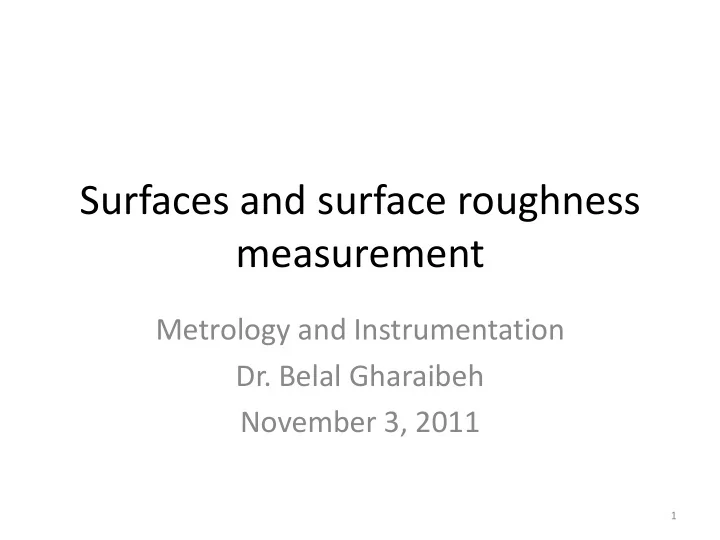

Surfaces and surface roughness measurement Metrology and Instrumentation Dr. Belal Gharaibeh November 3, 2011 1
Surface characteristics • No surface is perfectly smooth, but the better the surface quality, the longer a product generally lasts, and the better it performs. • Surface texture can be difficult to analyze quantitatively. Two surfaces may be entirely different, but have same surface measurement. • Recent developments in production technique, and metrology equipment have made it possible to specify and measure surface quality. • Surface Quality can be important when dealing with: – lubrication - small indentations can hold lubricant – resistant to wear - smoother surfaces wear less – tool life - rough surfaces will correlate to shorter tool life – fatigue/stress raisers – corrosion – smoother surfaces easier to clean, less surface area to erode – noise reduction - smooth surfaces make less noise when rubbing, for example meshing gears. – fit - pressure seals could leak through pits 2
3
Surface geometry • Flat and smooth are the two main surface geometries. Figure 1 • In reality, there is no perfect smooth and flat surface, therefore roughness and waviness need to be measured, figure 2 shows a common surface geometry Figure 2: The general features of surfaces, flatness and smoothness Figure 3: A surface with certain roughness and waviness 4
Terms in surface measurement • Surface texture - all of the details that make up a surface, including roughness, waviness, scratches, etc. • Lay - the direction of the roughness on a newly manufactured surface. The roughest profile will be perpendicular to the lay. • Flaws - small scratches, cracks, inclusions, etc. • Cutoff - a value selected to be less than the waviness, but greater than the roughness length. This is controlled using electrical or digital filters. Typical values might be; 0.010”, 0.030”, 0.100” 5
Measurements of surface roughness • A simple measure of roughness is the average area per unit length from the center-line (mean of all data taken). • Center Line Average (CLA), or Arithmetic Average (Ra), is the average value measured for a certain surface expressed in µm, or 1x10E-6 inch (one million of an inch) • Samples are taken at a certain location along the surface 6
Measurements of surface roughness • CLA can be also calculated by measuring the areas • In both methods the line is determined such that the sum of areas above the mean line is equal to the sum of areas below the line 7
Example: triangle surface profile The results are the same with both methods, however, if we take short line of measurement (less than 8) for the height method, then the readings will be different 8
Relation between CLA to total uncertainty of the measured part 9
10
Observation Methods • Human touch (feeling) can be used for general measurement however, human perception is highly relative because we can not compare it to a standard. • Commercial sets of standards are available shown in figure. The color (shine) indicates the surface finish depending on type of machining 11
Stylus Equipment • Example device: Brown & Sharpe Surfcom unit. • A stylus that tracks small changes in surface height, and a skid that follows large changes in surface height. The skid measures waviness changes and the stylus measures roughness • The relative motion between the skid and the stylus is measured with a magnetic circuit and induction coils. 12
Types of waviness measurement • Stylus position is compared to datum (reference point) which can be one of the three types: • Skid - can be used for regular frequency roughness • Shoe - can be used for irregular frequency roughness • Independent - can use an optical flat 13
1. Skid 14
2. Flat shoe 15
3. Independent: optical flat 16
The influence of scan location • If the texture of the surface changes in small sections on the surface, then the reading of roughness will change: 17
The influence of scan location • Ra would be higher over the longer sample (l2) than over the shorter sample (l1). 18
The influence of scan location • Ra would be higher over the longer sample (l2) than over the shorter sample (l1). 19
Details of surface roughness drawing • Waviness height - the distance from a peak to a valley • Waviness width - the distance between peaks or valleys • Roughness width cutoff - a value greater than the maximum roughness width that is the largest separation of surface irregularities included in the measurements. Typical values are (0.003”, 0.010”, 0.030”, 0.100”, 0.300”) • Lay - the direction the roughness pattern should follow Roughness Roughness Height width Roughness Width cutoff Waviness height Waviness width 20
21
Example on material and texture symbols on a mechanical part 22
Specifications of roughness and waviness on mechanical drawing • the manufacturing drawing should be shown to indicate the required roughness and waviness permitted, figure shows an example of a mechanical drawing with roughness drawing Surface roughness for a mechanical part 23
Details of surface roughness drawing 24
25
26
27
29
Recommend
More recommend